The Nanjing bowuyuan· (Nanjing Museum), the former Zhongyang bowuyuan· (Central Museum, · was founded in the 1930s by Mr. Cai Yuanpei. · After six decades of hardwork, the Museum possesses today over four hundred thousand objects, paintings and calligraphies, which provenance are archeological excavations, the imperial household and private collections, and enjoys a special reputation both in China and abroad.
The current exhibition** is constituted by eighty pieces dating back from the Neolithic Period til the end of the Qing· dynasty, covering a period of more than five thousand years. Besides a number of items found in tombs and digs (ills. 1 to 45) and others from the imperial household (ills.76,77,79,80) are displayed Han· dynasty wares (ills.35,38,40,42), from Sichuan· province, a Tang dynasty jar (ill.60) from Hunan· province and a silver case (i11.30) from Jiangsu province. Also present are items made of stone (ill.1), bone (ill.3), pottery (ills.7,8), jade (ills.11, 12,13,25,26,27), bronze (ills. 15,16,17,18,20), gold(ills.24, 28), copper (ill.29) and porcelain (ills.68,69), most of them considered masterpices by Chinese connoisseurs who cherished throughout the centuries and which bear witness to the great civilization of China. Some of these precious items are now exhibited for the first time outside the the Nanjing Museum's premises.
The jade objects (ills.1l, 12, 13) unearthed in Caoxieshan· constitute a major finding of the last decades. Their discovery altered previous theories about identical patrimonial articles belonging to the Zhou· period and the Shang· dynasty. These jades are now securely dated to two to three thousand years BC, to the Liangzhu· 'culture'. This 'culture', which thrived on the shores of Taihu· lake, created sophisticated jade objects with such finely engraved designs that, sometimes, their minutiae can only be seen through a magnifying glass. Many of these cult objects were used in communication rituals with divinities, symbolizing the remarkably humanist and transcendent spirit of archaic China, in a number of circumstances still preserved to the present. The peculiar artistic value of some paralelipipedric objects (ills. 11, 12) found in Caoxieshan and belonging to the Liangzhu 'culture', as well as the burial suit (ills.25,26,27) made of perforated jade segments stitched together with silver thread, unearthed from a tomb in Xuzhou, · reveal the high standart of ancient Chinese civilization.
Some of the most remarkable ceramic pieces displayed are those of coloured pottery (ills.7,8) dug-up at Dadunzi· in northern Jiangsu· province.
Chinese civilization was a foremost manufacturer of ceramics. The production of very fine green glazed stoneware in the southern regions bordering the Yangzi· river dates back to the Zhou dynasty and achieved consummate perfection during the Three Kingdoms· period. The large vase (ill.22) unearthed at Xiabadou, · in Dantu, · is considered a masterpiece of green glazed stoneware of the Zhou dynasty. The stoneware vase (ill.43) excavated at Ganjiaxiang is an imitation, in shape and design of a similar archaic bronze burial object exclusively present in the tombs of the powerful and noblemen of southern China. The impressive similarity of shape proportion of earthenware pots from the Three Kingdoms· period and the bronze vases from the Zhou dynasty and the Spring and Autumn· period, deliberately attempts to elevate the importance of the former to the important status ascribed to the latter. The glazed stonewares (ills.44,45) of the Western Jin· dynasty exhibit rich modeling of animalist representations. The eveness of the glaze throughout the capriciously curved surfaces is perfectly achieved by the master ceramicists. Glazed stoneware objects of the Tang· dynasty manufactured at Tongguanyao·(Tong Imperial Kiln) such as the displayed jar (i11.60), popular items (ills.65,66) of Song dynasty, thrown at the Cizhou· kilns, and those made centuries later exclusively to the Qing court, (ills.76,77,79,80) are all revealing masterpieces of the historical evolution of Chinese ceramics. They constitute a representative cross selection of China's most outstanding achievements.
The objects made out of bronze, gold and silver selected for this exhibition are also works of superb craftsmanship and artistry. The bronze objects (ills.15, 16, 17, 18, 20) found in tombs in Jiangsu· province span from the Shang dynasty (ca 1700-1200BC) to the Spring and Autumn period (ca770-476BC). Their shape is similar to Neolithic pottery found in the Zhongyuan· (Central Plain) having, however, geometrical designs. The container with two handles (ill. 16), the gui (ill. 17) and the zun ·with scale design (ill.18) belong to this type of bronze, pieces. The nao ·(ill.15) and the bianzhong · (ill.20) were found in a royal tomb in the ancient Xu· kingdom. The golden animal (ill.24) found at NanYuaoZhuang, · in Xuyi, · from the Western Han· dynasty is an exquisitely executed piece. It weighs nine kilograms and is the heaviest solid gold object discovered up until now. It is an extremely rare example of the Chinese artistic heritage.
All these pieces reflect the grandeur of the millenary culture of China. ***
 1
KNIFE WITH SEVEN EYES
Stone (polished diorite)
Neolithic period, Beiyingyangying· culture (ca4000-ca3OOOBC).
(length) →: 22.6 cm; (width) ←: 6.3 cm; (depth)
1
KNIFE WITH SEVEN EYES
Stone (polished diorite)
Neolithic period, Beiyingyangying· culture (ca4000-ca3OOOBC).
(length) →: 22.6 cm; (width) ←: 6.3 cm; (depth)  : 1.2 cm.
Unearthed in Beiyingyangying, in Nanjing. In the shape of a rectangular plate, slightly curved, with seven holes and sharp on both sides.
: 1.2 cm.
Unearthed in Beiyingyangying, in Nanjing. In the shape of a rectangular plate, slightly curved, with seven holes and sharp on both sides.
 25, 26, 27
BURIAL SUIT
Jade pieces stitched with silver thread
Eastern Han· dynasty (AD25-220).
Overall →: 170.0 cm.
Unearthed in Xuzhou, · Jiangsu province.
Male suit composed of the skull, face, chest, back, limbs, hands, feet and coverings. In all, there are nine pieces of perforated jade fragments, near the vertices, where the silver thread links them up. Each one of the nine pieces is hemmed with yellow silk. The entire suit contains more than two thousand six hundred jade fragments and about eight hundred grams of silver thread. A jade pig can be seen on both sides.
25, 26, 27
BURIAL SUIT
Jade pieces stitched with silver thread
Eastern Han· dynasty (AD25-220).
Overall →: 170.0 cm.
Unearthed in Xuzhou, · Jiangsu province.
Male suit composed of the skull, face, chest, back, limbs, hands, feet and coverings. In all, there are nine pieces of perforated jade fragments, near the vertices, where the silver thread links them up. Each one of the nine pieces is hemmed with yellow silk. The entire suit contains more than two thousand six hundred jade fragments and about eight hundred grams of silver thread. A jade pig can be seen on both sides.
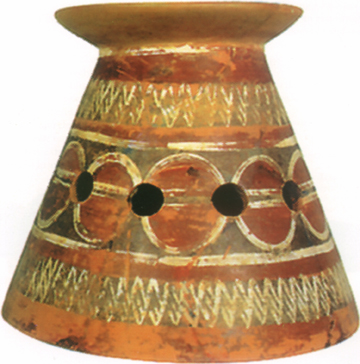 7
STAND
Coloured pottery
Neolithic, Dawenkou culture (ca 4300-ca2500BC)(heigth) ↑:24.1 cm; (diameter) Ø of mouth: 19.0 cm; Ø of base: 26.8 cm.
Unearthed in Dadunzi, Pi district, Jiangsu province.
In conical shape, has markedly twelve holes in the middle and painted in lilac and decorated with designs of half-moon and grille-work in black and white.
7
STAND
Coloured pottery
Neolithic, Dawenkou culture (ca 4300-ca2500BC)(heigth) ↑:24.1 cm; (diameter) Ø of mouth: 19.0 cm; Ø of base: 26.8 cm.
Unearthed in Dadunzi, Pi district, Jiangsu province.
In conical shape, has markedly twelve holes in the middle and painted in lilac and decorated with designs of half-moon and grille-work in black and white.
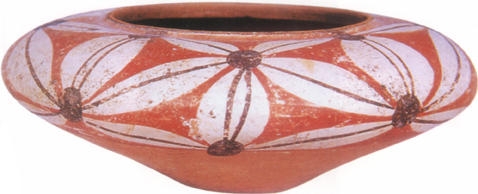 8
BOWL (BO) ·
Pottery painted with flowers
Neolithic period, Dawenkou culture (ca 4300- ca 2500BC)↑: 9.4 cm; Ø of mouth: 14.0 cm.
Unearthed in Dadunzi, Pi district, Jiangsu province.
Low, bulgy, painted in white, violet and brown.
8
BOWL (BO) ·
Pottery painted with flowers
Neolithic period, Dawenkou culture (ca 4300- ca 2500BC)↑: 9.4 cm; Ø of mouth: 14.0 cm.
Unearthed in Dadunzi, Pi district, Jiangsu province.
Low, bulgy, painted in white, violet and brown.
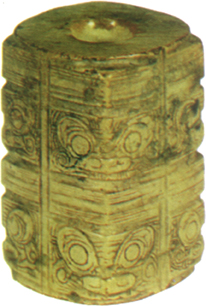 11
SCULPTURE (CONG)·
Jade (tremolite)
Neolithic period, Liangzhu culture (ca 3300- ca 2200BC).
←: 3.2 cm; ↑: 5.1 cm.
Unearthed in Caoxieshan, Wu· district, Jiangsu province.
Cilindrically shaped on the inside, square shaped on the outside, with two openings opposite each other and designs of animal heads.
11
SCULPTURE (CONG)·
Jade (tremolite)
Neolithic period, Liangzhu culture (ca 3300- ca 2200BC).
←: 3.2 cm; ↑: 5.1 cm.
Unearthed in Caoxieshan, Wu· district, Jiangsu province.
Cilindrically shaped on the inside, square shaped on the outside, with two openings opposite each other and designs of animal heads.
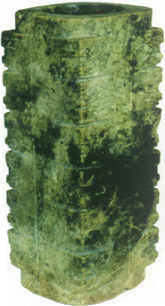 12
SCULPTURE (CONG)
Jade (actinolite)
Neolithic period, Liangzhu culture (ca 3300- ca 2200BC).
←: 7.0 cm; ← of inner cavity: 6.6 cm; ↑: 18.0 cm.
Unearthed in Caoxieshan, Wu district, Jiangsu province.
Cilindrically shaped on the inside, square shaped on the outside, with two openings opposite each other having a longitudinal groove and six oblique divisions on each face and, on the upper part, having two prominent edges that represent a crest, two circles representing eyes, one edge forming the base of the nose, all making up a simplification of a human face.
12
SCULPTURE (CONG)
Jade (actinolite)
Neolithic period, Liangzhu culture (ca 3300- ca 2200BC).
←: 7.0 cm; ← of inner cavity: 6.6 cm; ↑: 18.0 cm.
Unearthed in Caoxieshan, Wu district, Jiangsu province.
Cilindrically shaped on the inside, square shaped on the outside, with two openings opposite each other having a longitudinal groove and six oblique divisions on each face and, on the upper part, having two prominent edges that represent a crest, two circles representing eyes, one edge forming the base of the nose, all making up a simplification of a human face.
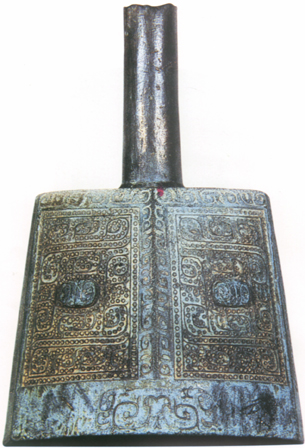 15
MUSICAL INSTRUMENT (NAO)
Bronze
Shang dynasty (ca 1600- ca 900BC).
←: 31.0 cm; →: 46.0 cm.
Unearthed in Hengxi, · Jiangning district, Jiangsu province.
The case is decorated with heads of animals arranged in spiral form.
15
MUSICAL INSTRUMENT (NAO)
Bronze
Shang dynasty (ca 1600- ca 900BC).
←: 31.0 cm; →: 46.0 cm.
Unearthed in Hengxi, · Jiangning district, Jiangsu province.
The case is decorated with heads of animals arranged in spiral form.
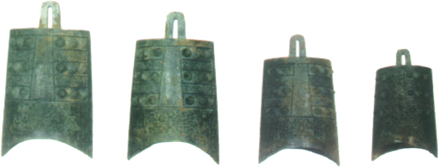 20
MUSICAL INSTRUMENT (BIANZHONG) ·
Bronze
Spring and Autumn· period(ca 700-476BC).
↑ of biggest element: 25.0 cm; ↑ of smallest element: 14.5 cm.
Part of a set of seven elements unearthed in Beishanding, Dantu district, Jiangsu province.
The apexes are rectangular in shape. The belly and the drums of the bells are decorated with various inscriptions and two hornless dragons.
20
MUSICAL INSTRUMENT (BIANZHONG) ·
Bronze
Spring and Autumn· period(ca 700-476BC).
↑ of biggest element: 25.0 cm; ↑ of smallest element: 14.5 cm.
Part of a set of seven elements unearthed in Beishanding, Dantu district, Jiangsu province.
The apexes are rectangular in shape. The belly and the drums of the bells are decorated with various inscriptions and two hornless dragons.
 16
CONTAINER WITH TWO HANDLES
Bronze
Zhou dynasty (ca 1100-771BC).
↑: 25.4 cm; Ø of dish: 48.9 cm; Ø of base: 32.7 cm.
Unearthed in Yundunshan, · Dantu district, Jiangsu province.
Belly decorated with snakes' designs.
16
CONTAINER WITH TWO HANDLES
Bronze
Zhou dynasty (ca 1100-771BC).
↑: 25.4 cm; Ø of dish: 48.9 cm; Ø of base: 32.7 cm.
Unearthed in Yundunshan, · Dantu district, Jiangsu province.
Belly decorated with snakes' designs.
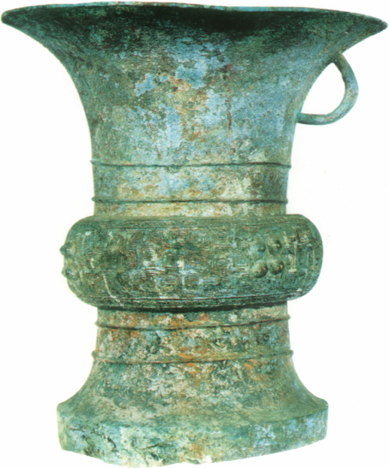 18
VESSEL (ZUN) ·
Bronze
Spring and Autumn period (ca 770-476BC).
↑: 25.4 cm; Ø of mouth: 34.5 cm; Ø of body: 24.1 cm.
Unearthed in Mopandun· Dantu district, Jiangsu province.
Decorated with motifs of cords and clouds near the base, a string of beads on the bulgy section, and motifs of clouds and thunders and four groups of four beaks.
18
VESSEL (ZUN) ·
Bronze
Spring and Autumn period (ca 770-476BC).
↑: 25.4 cm; Ø of mouth: 34.5 cm; Ø of body: 24.1 cm.
Unearthed in Mopandun· Dantu district, Jiangsu province.
Decorated with motifs of cords and clouds near the base, a string of beads on the bulgy section, and motifs of clouds and thunders and four groups of four beaks.
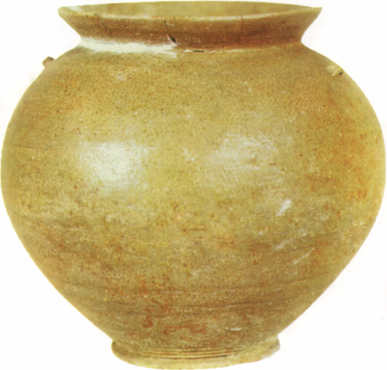
22
VASE (GUAN) ·
Green glazed stoneware
Zhou dynasty (ca 1100-771BC).
↑: 27.0 cm; Ø:22.0 cm.
Unearthed in Xiaobadou, · Dantu district, Jiangsu province.
Has two handles and the top portion of the belly is decorated with checkered motifs under a pale green glaze.
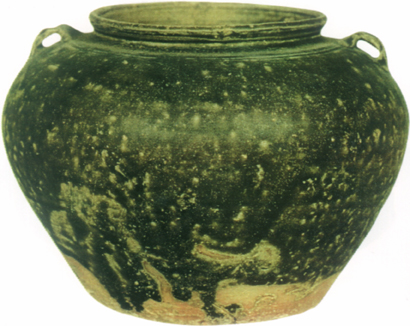
43
VASE (GUAN)
Glazed stoneware
Three Kingdoms period (220-265).
↑: 12.3 cm; Ø:9.9 cm.
Unearthed in Ganjiaxiang, Qixiashan, · Jiangsu province.
Wide mouth, round belly, with two handles. The upper portion decorated with rope-shaped lines and feather motifs under a yellowish green glaze.
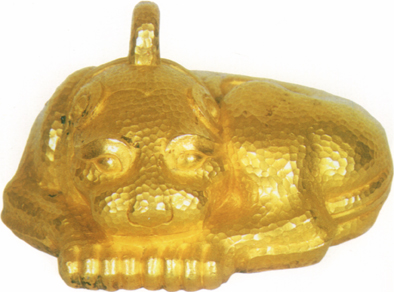
24
ANIMAL
Solid gold
Western Han dynasty (206BC-AD8).
↑: 12.3 cm; Ø:9.9 cm.
Unearthed in Nanyaozhuang, · Xuyi· district, Jiangsu province.
The animal is bent on its fore-feet, with eyes open and ears dropped. The body is covered with irregular round-shaped marks. Around the neck is engraved a three-round collar with a round button. At the base, is a small cavity, with two characters engraved: huang liu 黃六 (lit.: Yellow-Six).
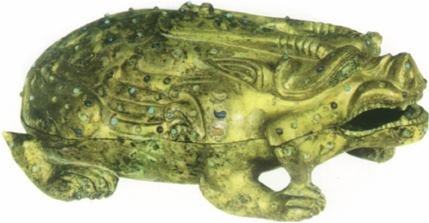
28
INKSTAND
Gold, copper and gems
Eastern Han dynasty (25-220).
→: 25.0 cm; ←: 14.8 cm; ↑: 10.0 cm.
Unearthed in Xuzhou, Jiangsu province.
The inkstand has the shape of a strange animal that crawls with open-bones and visible teeth. The interior of the jaw-bones is the ink-well. The dorsal has a pair of wings and a rectangular handle. The curved tail is hidden underneath the body. The body is covered in gold and inlaid with coral, lapis lazuli and turquoises.
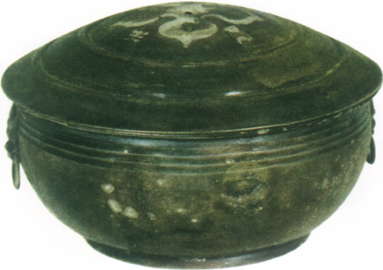
30
CASE
Silver
Eastern Han dynasty (25-220).
↑:6.2 cm; Ø: 9.6 cm.
Unearthed in Xuzhou, Jiangsu province.
Round shaped, the cover is decorated with four petals, each one originally exhibiting a turquoise, of which only one remains.
Between the petals are engraved the four characters of changsheng dashou 長生大壽 (Long Life).
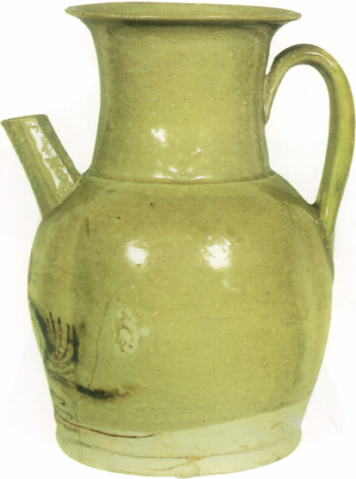
60
JAR
Glazed stoneware
Tang dynasty (618-907).
↑: 19.8 cm; Ø:10.2 cm.
Unearthed in the Tongguanyao, Changsha, · Hunan· province.
Upturned edge, wide bottleneck, belly in the shape of melon slices. Beak and handle. Green glaze. Decoration in shades of brown.
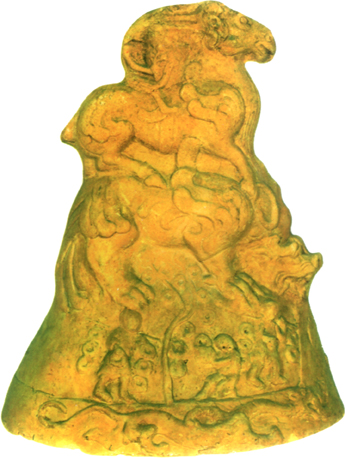
35
STAND IN SHAPE OF MONEY-TREE
Earthenware
Eastern Han dynasty (25-220).
→: 50.0 cm; ←: 38.0 cm; ↑: 60.5 cm.
Unearthed from a tomb in Pengshan, · Sichuan province.
Conical shape, hollow inside, oval base. Near the base it has three human figures, and at the top a mythological animal, on whose back there is a goat with wings. On top of the cavity there is a cavity.
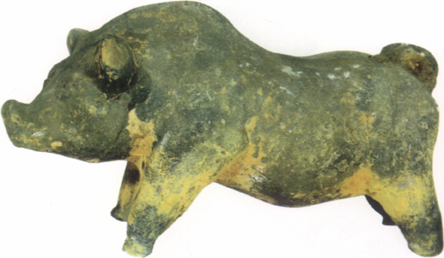
42
PIG
Greyish earthenware
Eastern Han dynasty (25-220).
→: 24.0 cm; ↑: 13.0 cm.
Unearthed from a tomb in Pengyashan, Sichuan province.
Tumular statuette. Made in two pieces: head and body. The inner part of the ears are painted in red. Very vivid forms.
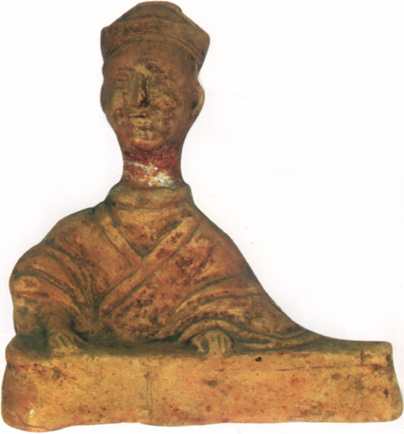
38
MUSICIAN
Earthenware
Eastern Han dynasty (25-220).
↑: 27.5 cm.
Unearthed from a tomb in Pengyashan, Sichuan province.
Tumular statuette representing a musician seated on the ground, playing guzheng, · — an ancient string instrument — with a joyful smile. Made in two pieces: head and body. Round collar, vestment with front outlines, waistband.
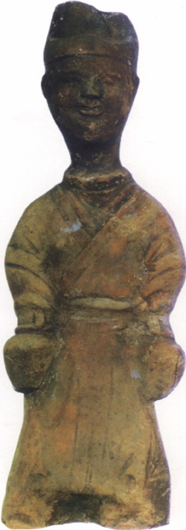
40
WOMAN HOLDING TWO POTS
Earthenware
Eastern Han dynasty (25-220).
↑: 46.0 cm.
Unearthed from a tomb in Pengyashan, Sichuan province.
Tumular statuette representing a kneeling woman, holding two pots. Hair combed in the shape of a bun, round neckline and vestment with front outlines, slightly visible breasts, and waistaband.
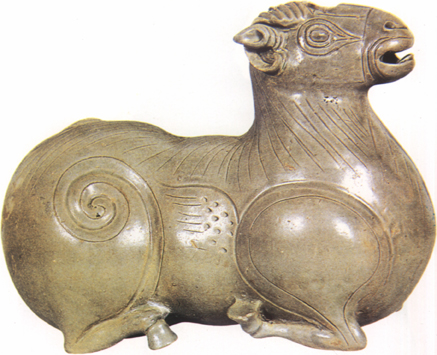
44
SHEEP
Glazed stoneware (qingci) ·
Western Jin· dynasty (265-316).
→: 26.0 cm; ↑: 19.7 cm.
Unearthed in Xigang, ·Nanjing.
Sheep lying down, protruding muscles, double horned, wings at sides. Greyish green glaze.
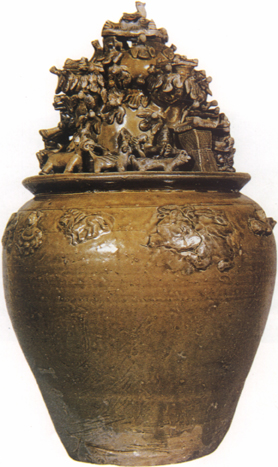
45
VASE
Glazed stoneware (qingci)
Western Jin dynasty (265-316).
↑: 16.5 cm; Ø: 16.5 cm.
Unearthed in Xigang, Nanjing.
Human figures, pigeons, birds, pagoda, house and lion decorated over the mouth. Greyish green glaze with a yellowish portion, belly decorated with human and animal figures.
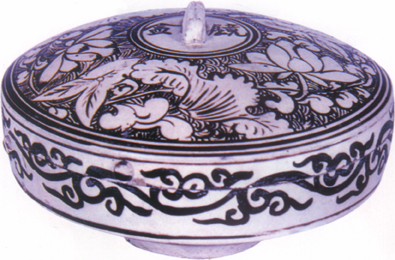
65
COSMETIC-BOX
Glazed stoneware (cizhou) ·
Northern Scng· dynasty (960-1127).
↑: 12.2 cm; body Ø: 19.3 cm; foot Ø: 8.5 cm..
Manufactured at the Cizhou kiln.
Vaulted cover with handle in the centre and an opening underneath, decorated with lotus flower motifs. On the sides of the handle there are two characters jing he 鏡盒 (Mirror-Box). Around is decorated with plant motifs. Decorations in black on white background. The inner side of cover is not glazed, but the base is glazed in brown.
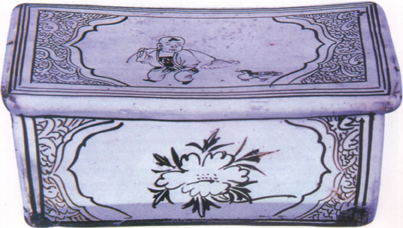
66
PILLOW
Glazed stoneware (cizhou)
Song· dynasty (960-1280).
↑: 13.4 cm; headrest →: 29.8 cm; ←: 17.3 cm; base →: 26.4 cm; ←: 13.1 cm;
Manufactured at the Cizhou kiln.
In the shape of a brick. Decorated in black on white background. On the headrest surface is painted a child playing with a swan. The four lateral surfaces are decorated with flowers and, in one of them, there are five characters indicating the author of the piece.
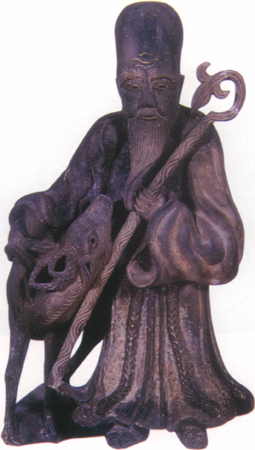
68
GOD OF LONGEVITY
Stone
Ming· dynasty (1368-1644).
↑: 30.5 cm.
Unearthed from Xu yufu· tomb, Wu district, Jiangsu province.
Thick eyebrows, big eyes, beard to chest. Long walking-stick in one hand, waistband, barefooted, clothed with wide-sleeve tunic. A stag at the side.
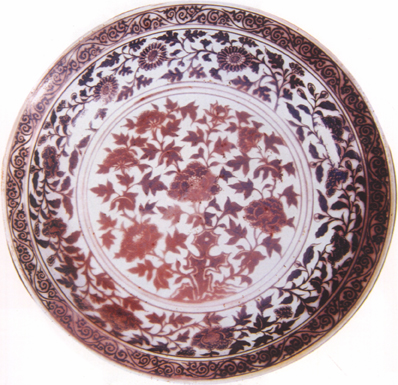
69
PLATE
Porcelain
Ming dynasty (1368-1644).
↑: 10.2 cm; Ø:57.0 cm.
Decorated in copper red underglaze with motifs of plants along the border and four flowers (camelia, peony, chrysanthemum and pomegranate). At the bottom centre there is a rock covered by three peonies.
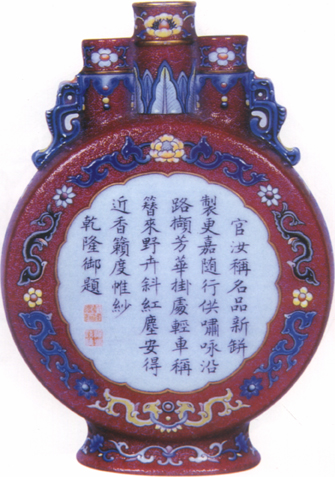
76
WALL VASE
Porcelain
Qing dynasty (1644-1911); Qianlong reign (1736-1795).
↑: 17.8 cm; Ø:7.0 cm.
Decorated with Famille Rose enamel overglaze. Triple-tank with two wings between the bottle-neck and belly, decorated with dragon and plums motifs.
At the centre there is a poem by the Qianlong emperor with two seals.
At the base, the mark Qianlong nianzhi 乾隆年制 (Manufactured in Qianlong's Reign of the Qing Dynasty).
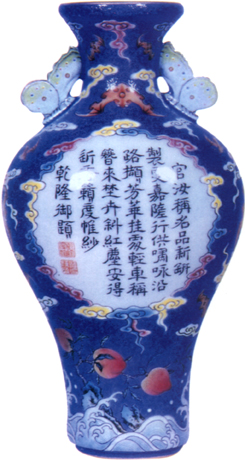
77
WALL VASE
Porcelain
Qing dynasty (1644-1911); Qianlong reign (1736-1795).
↑: 18.6 cm; Ø:5.0 cm.
Decorated with Famille Rose enamel overglaze. Decorative object of the Imperial Court. Contains a pair of lateral wings in the shape of a butterfly.
Decorated with clouds, peach and bat motifs. At the centre there is a poem by the Qianlong emperor with two seals.
At the base, the mark Qianlong nianzhi 乾隆年制 (Manufactured in Qianlong's Reign of the Qing Dynasty).
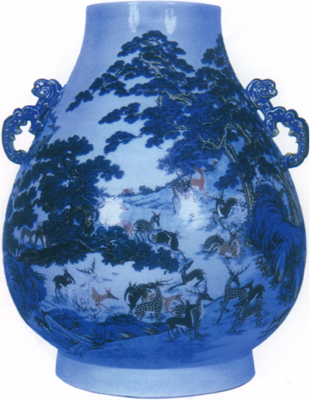
79
VASE
Porcelain
Qing dynasty (1644-1911); Qianlong reign (1736-1795).
↑: 45.3 cm; body Ø: 24.4 cm; base Ø: 16.3 cm.
Decorated with Famille Rose enamel overglaze. Decorative object of the Imperial Court. Contains a pair of lateral wings in the shape of a dragon.
Decorated with 'bailu'· ('hundred stags') in the forest over a white background.
At the base, the mark Qianlong nianzhi 乾隆年制 (Manufactured in Qianlong's Reign of the Qing Dynasty).
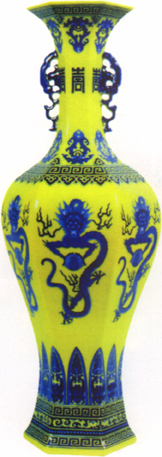
80
VASE
Porcelain
Qing dynasty (1644-1911); Qianlong reign (1736-1795).
↑: 57.0 cm; body Ø: 13.1 cm; base Ø: 12.4 cm.
Decorated with dragons and flowers in underglaze blue on yellow ground. Decorative object of the Imperial Court. Hexagonal shape, with long bottleneck, round belly, narrowing towards the base.
At the base, the mark Qianlong nianzhi 乾隆年制 (Manufactured in Qianlong's Reign of the Qing Dynasty).
*** Whenever possible the following illustrations are in chronological succession.
Adapted from the Portuguese version by: João Líbano.
** Revised reprint from: Tesouros do Museu de Nanjing / Treasures of Nanjing Museum, Macau, Macau Cultural Institute - Macau Urban Council, 1996 — Catalogue of an exhibition held at the Centro de Actividades Turísticas / Tourist Activities Centre, from the 28th of March 1996 to the 28th of April 1996.
* Vice-Director the Nanjing Museum, in Nanjing.
start p. 169
end p.